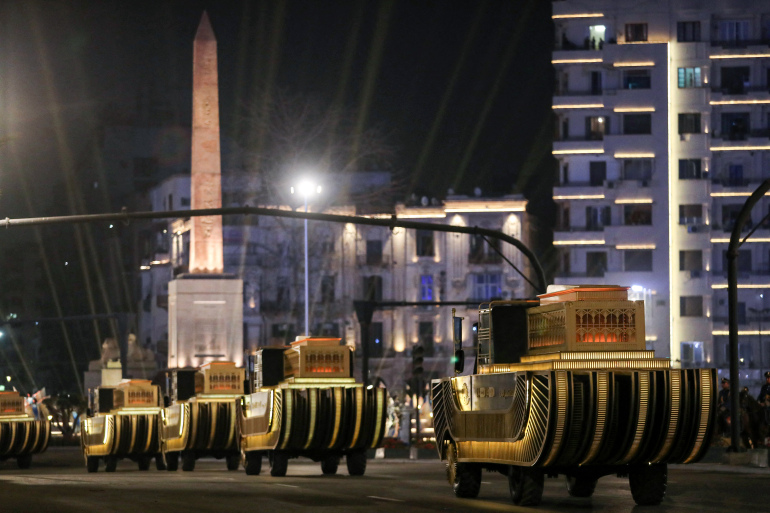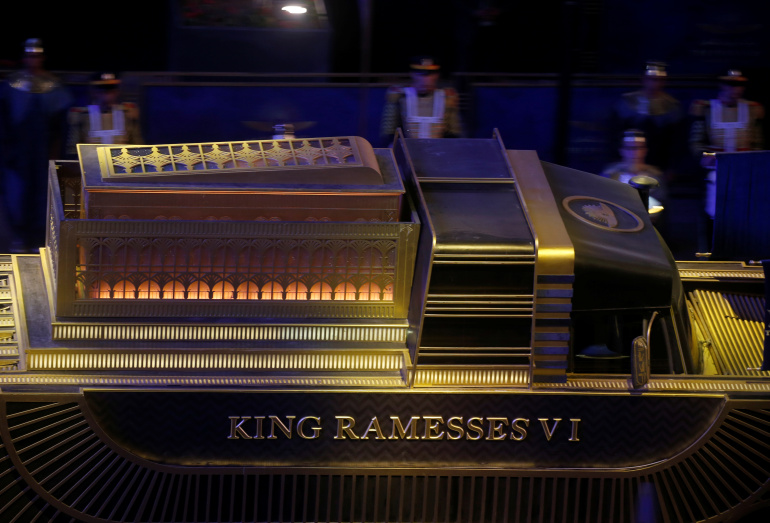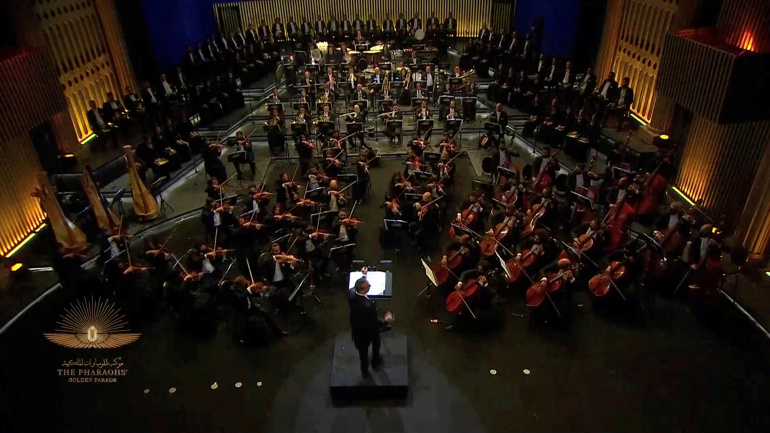Egypt has held a spectacular parade to celebrate the transport of 22 of its ancient royal mummies through the capital, Cairo, to their new home in the National Museum of Egyptian Civilisation.
Crowds on Saturday gathered to witness the multimillion-dollar spectacle of the 18 kings and four queens making the 7km journey (four miles) to their new resting place.
Under heavy security, the mummified remains of the pharaohs and other royals were transported in climate-controlled cases loaded onto trucks decorated with wings and pharaonic design for the hour-long journey from their previous home in the older, Egyptian Museum.
The vehicles were designed to appear like the ancient boats used to carry deceased pharaohs to their tombs.
‘What a night’
The “Pharaohs’ Golden Parade” was broadcast live on the country’s state-run television and other satellite stations, as well as on official social media platforms.
Salima Ikram, head of the Egyptology unit at the American University in Cairo, told Al Jazeera the spectacle was “extremely moving”.
“In a way, people are very proud of what they are seeing,” she said. “So although there was great expense, I think the return may be quite good in the long run.”
Archaeologist Nigel Hetherington shared the enthusiasm. “What a night, absolutely amazing – just wants to make you be in Egypt,” he told Al Jazeera from Cumbria in the United Kingdom after following the proceedings online.
“When these mummies were moved to the museum in the first place after their discovery, of course we’ve got photographs and the rest of it, but it’s not the same as actually witnessing. It’s truly a momentous occasion,” said Hetherington.
“You can imagine that they’ve been working on it a very long time and I think they’ve pulled it off – there was the spectacle but we also felt that everything was done safely; obviously these are irreplaceable royal ancestors, so every care had to be taken.”
 The carriages carrying the mummies advance past the Obelisk of Ramses II along Tahrir Square [Mahmoud Khaled/AFP]
The carriages carrying the mummies advance past the Obelisk of Ramses II along Tahrir Square [Mahmoud Khaled/AFP]
Most of the mummies belong to the ancient New Kingdom, which ruled Egypt between 1539 BC to 1075 BC, according to the ministry of antiquities.
They included Ramses II, one of the country’s most famous pharaohs, and Queen Hatshepsut, Egypt’s only woman pharaoh – who wore a false beard to overcome tradition requiring women to play only secondary roles in the royal hierarchy.
The mummies were originally buried some 3,000 years ago in secret tombs in the Valley of Kings and the nearby Deir el-Bahri site. Both areas are near the southern city of Luxor. The tombs were first excavated in the 19th century.
After excavation, the mummies were taken to Cairo by boats that sailed the Nile. Some were showcased in glass cases, while others were stored.
The remains of Ramses II were taken to Paris in 1976 for intensive restoration work by French scientists.
 The mummy of King Ramesses VI [Amr Abdallah Dalsh/Reuters]
The mummy of King Ramesses VI [Amr Abdallah Dalsh/Reuters]‘Proof of greatness’
The made-for-TV parade was part of Egypt’s efforts to attract foreign tourists by publicising its ancient artefacts.
The tourism industry has been reeling from political turmoil following the 2011 popular uprising that toppled longtime autocrat Hosni Mubarak, and more recently, the coronavirus pandemic.
“With great pride, I look forward to welcoming kings and queens from Egypt after their trip,” President Abdel Fattah el-Sisi posted on Twitter shortly before the proceedings took place.
“This grandiose spectacle is further proof of the greatness … of a unique civilisation that extends into the depths of history,” he added.
The parade circled Tahrir Square, where authorities officially unveiled an obelisk and four sphinxes to now decorate Cairo’s most famous square.
“Again, Egypt dazzles the world with an unrivalled event,” said film star Hussein Fahmy in an official promotional video.
Once at the new museum, 20 of the mummies will be displayed, while the remaining two will be stored, according to the ministry.
 A musical performance that was part of the proceedings [Reuters]
A musical performance that was part of the proceedings [Reuters]




